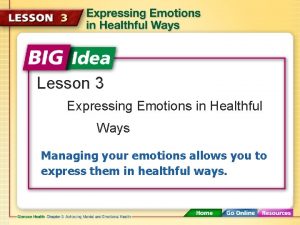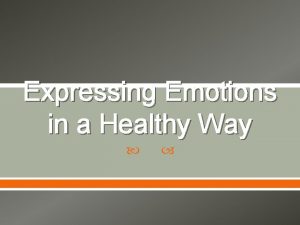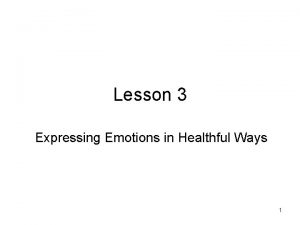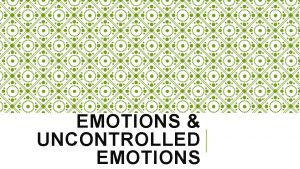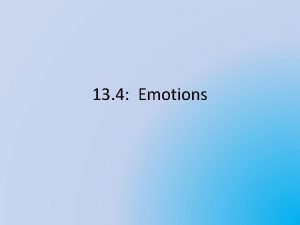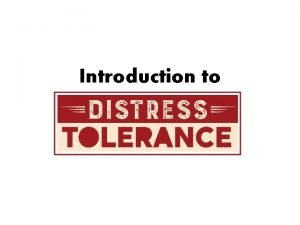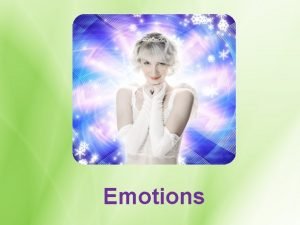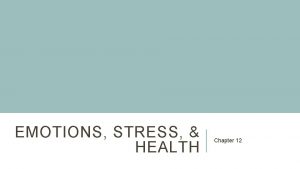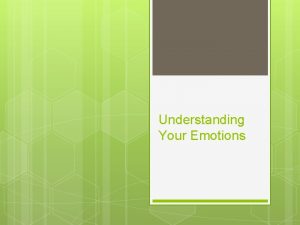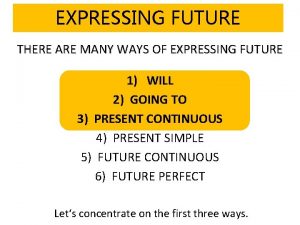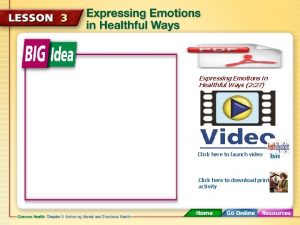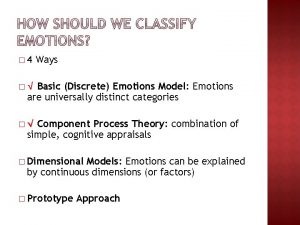Lesson 8 Expressing Emotions in Healthy Ways Ways

















- Slides: 17

Lesson 8 Expressing Emotions in Healthy Ways

Ways to express emotions • Spoken words • Written or printed words, • Sign language, • Actions

Communication: sharing of emotions, thoughts, and information with another person • Emotion: a specific feeling. • What are some types of emotions

Names of Types of Emotions • • • Depressed Optimistic Disgusted Rejected Envious Jealous Stressed Excited Happy Anxious • • • Lonely Angry Loving Anxious Nervous Sad Frustrated Shy Surprised Afraid

• Mind-body connection: close relationship between mental and physical responses. • Psychosomatic disease: a physical disorder caused or aggravated by emotional responses.

5 Guidelines to Express Emotions in Healthy Ways • Identify the emotion • Identify the source of the emotion • Decide whether or not you need to respond immediately • Choose a responsible and healthful response • Protect your health

Nonverbal communications & mixed messages • Actions also express how you feel • Nonverbal behavior: use of actions to express emotions and thoughts • Mixed message: message that gives out two different meaning.

I-Messages • I-message: a statement that contains a specific behavior or event, the effect of the behavior or event on a person, and the emotions that result. – Express emotions without blaming someone • You-message: a statement that blames or shames another person. – Puts down another person for what they have done

Active Listening • Active listening: a way of responding to show that a person hears and understands. – Ask more information (clarify response) – Repeat what the speaker has said in their words – Summarize the response – Acknowledge and show appreciation for the speaker’s feelings (confirm response)

Why Don’t You Listen? • • • Thinking of something or someone else Could not hear the speaker Tired, sleepy, dozing off Thinking about what to say next Distracted by something else You thought you knew what the speaker was going to say next

ANGER • Anger: the feeling of being irritated or annoyed. – Usually the response to being hurt, frustrated, insulted or rejected. • Anger trigger: a thought or event that causes a person to become angry. • Anger cue: a body change that occurs when a person is angry. – Fight or flight response

Anger Cues: • • Rapid breathing Increased heart rate Rise in blood pressure Increased sweating Sweaty palms Dryness of mouth Increased alertness • Decreased sensitivity to pain • Increased muscle strength • Tensed eyebrows • Pursed lips • Reddening of the face

HIDDEN ANGER • Hidden anger: anger that is not recognized and is expressed in an inappropriate way. • Hostility syndrome: a physical state in which the body is in the fight or flight state at all times. – Serotonin: chemical that regulates primitive drives and emotions.

HIDDEN ANGER • Projection: blaming others for actions or events for which they are not responsible. • Displacement: releasing of anger on someone or something other than the cause of the anger.

Anger Management Skills • Healthy ways to control and express anger

10 Anger Management Skills • Anger self-inventory – What am I feeling? – What is causing me to feel this way – Is my anger justified – Am I still angry – What are healthy ways to express my anger • Use self-statements to control anger – Words a person can say to themselves when they experience anger triggers and cues.

• • Use I-messages instead of you-messages Write a letter Write a journal Reduce the effects of anger cues with physical activity Use safe physical actions to blow of steam Keep a sense of humor Rehearse what to do in situations that you know triggers anger Talk with parents or mentor.
 3 healthful ways to manage difficult emotions
3 healthful ways to manage difficult emotions Chapter 3 achieving mental and emotional health answer key
Chapter 3 achieving mental and emotional health answer key What is the most obvious channel of expressing emotions
What is the most obvious channel of expressing emotions What is the most obvious channel of expressing emotions
What is the most obvious channel of expressing emotions Time markes
Time markes Ways of expressing future tense
Ways of expressing future tense Ways of expressing future tense
Ways of expressing future tense Ways of expressing future
Ways of expressing future Ways of expressing algorithms
Ways of expressing algorithms Scientific notation definition
Scientific notation definition Definition scientific notation
Definition scientific notation Expressing the future
Expressing the future Ways of expressing future actions
Ways of expressing future actions Future forms in english
Future forms in english Journal on healthy food healthy mind
Journal on healthy food healthy mind Healthy soil healthy life poster ideas
Healthy soil healthy life poster ideas Healthy community poster
Healthy community poster Healthy nurse healthy nation
Healthy nurse healthy nation
